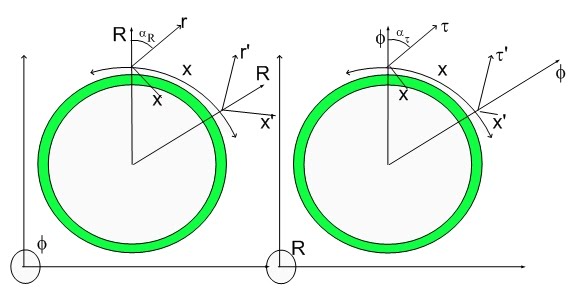Posted by: M P 17 years, 1 month ago
 Pion Minus Decay Details
Pion Minus Decay Details
I should repeat the same detailed description I created for the Delta decay.
A complex coherence sequence with multiple fundamental dilator chords is a polymer, in the sense that its 3D representation seemingly contains more than one particle. In reality, one should be able to see three particles (does that rings a Bell someplace) in the case of a Pion Minus, two in the case of a Neutron...
The decaying reaction for the trimeric Pion Minus can be redrawn as:
Please click the picture to see a larger version of it. The left side fo the decaying equation is the Pion Minus coherence followed up to six Fundamental Dilator Cycles (FDC) This is because the Pion Minus is a trimer thus it requires three FDC to cover a full cycle while the Muon Neutrino Transient State is a dimer. The minimum common multiple is six Fundamental Dilator Cycles.
Of course, each Balls Diagram has a corresponding state diagram. The Pion Minus corresponds to the following coherence:

Reading the coherence from left to right, one can identify:
1) Electron Fundamental Dilator
2) Half-Muon Neutrino (Electron-Positron Transmutation Chord - the blue line).
3) Positron Fundamental Dilator
4) Half-Muon Neutrino (Electron-Positron Transmutation Chord - the blue line).
5) Electron Fundamental Dilator
6) Electron - Proton Transmutation Chord followed by an Proton-Electron Transmutation Chord. This is equivalent to an Electron Neutrino.
Just for sake of being throrough let's revise the Neutron Balls and Coherence Diagrams. and its Coherence Diagram:
and its Coherence Diagram:
Reading the coherence from left to right, one can identify:
1) Electron Fundamental Dilator
2) Half ElectronNeutrino (Electron-Proton Transmutation Chord - the red line).
3) Proton Fundamental Dilator
4) Half ElectronNeutrino (Electron-Proton Transmutation Chord - the red line).
6) Electron - Proton Transmutation Chord followed by an Proton-Electron Transmutation Chord. This is equivalent to an Electron Neutrino.
The only three construct that one requires to understand are the Fundamental Dilator, the Electron-Proton Transmutation Chord and the Electron-Positron Transmutation Chord. All Hyperons, and isotopes are just combinations of those three elements.
Of course, isotopes are even simpler. They only have protons and neutrons or fundamental dilators and Electron-Proton and Proton-Electron Transmutation Chords. Since isotopes are complex coherences, their 3D representation is a very, very complex tridimensional rotating object composed of many fundamental dilators.
Please feel free to ask any questions.
Cheers,
MP
Archive
2017
2016
2015
2014
2013
2012
2011
2010
2009
2008
- December (5)
- November (4)
- October (13)
- September (7)
- August (5)
- July (6)
- June (5)
- May (5)
- April (7)
- March (6)
- February (7)
- January (5)
2007
- December (4)
- November (13)
- October (10)
- September (3)
- August (24)
- July (12)
- June (2)
- May (1)
- March (4)
- February (12)
- January (4)
2006
Categories
- Brian Greene (1)
- Censorship (8)
- Coherent Nuclear Fusion (1)
- Erik Anson (3)
- Hypergeometrical Universe (290)
- Kip Thorne (1)
- Lawrence M. Krauss (1)
- Max Tegmark (1)
- Michio Kaku (2)
- Neil deGrasse Tyson (1)
- Paul Ginsparg (1)
- Science News (2)
- Sheldon Glashow (1)
- The Undiscovered Continent (1)

Comments
There are currently no comments
New Comment